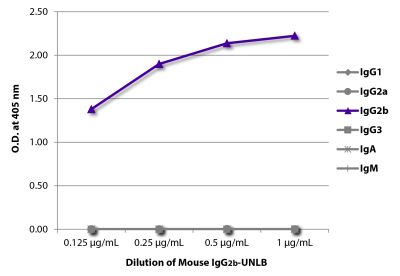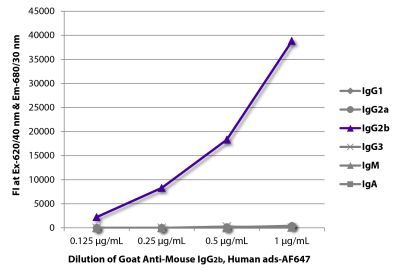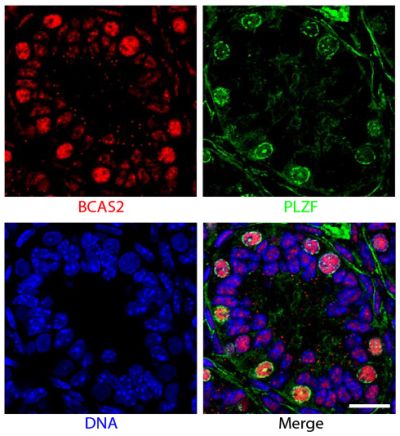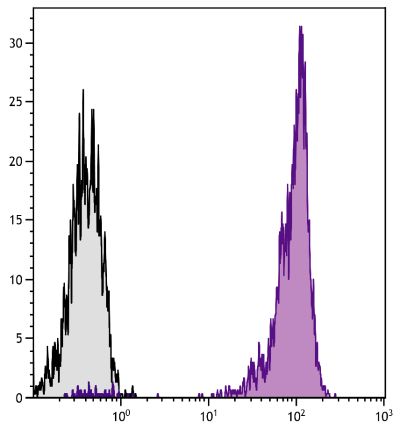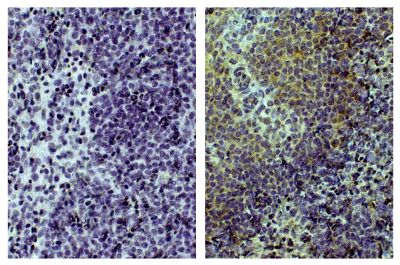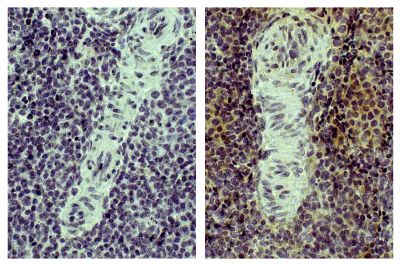Mouse Anti-Chicken CD8α-UNLB (3-298)
Cat. No.:
8405-01
Purified Anti-Chicken CD8α antibody for use in flow cytometry, immunohistochemistry, western blot, immunoprecipitation, and separation assays.
$278.00
| Clone | 3-298 |
|---|---|
| Isotype | Mouse IgG2bκ |
| Isotype Control | Mouse IgG2b-UNLB (A-1) |
| Specificity | Chicken/Turkey CD8α |
| Description | In the chicken the CD8 molecule is present in two forms - (i) a homodimer of two α chains and (ii) a heterodimer of an α chain and a β chain. Chicken CD8 is expressed on approximately 80% of thymocytes, 45% of blood mononuclear cells, and 50% of spleen cells but less than 1% of cells in the bursa and bone marrow. While the vast majority of CD8+ cells in the thymus, spleen, and blood of adult chickens express both CD8α- and CD8β-chains, a relatively large proportion of the CD8+ TCRγδ cells in the spleens of embryos and young chicks express only the α-chain of CD8. Among intestinal epithelial lymphocytes, the major CD8+ T cell populations present in mice are conserved but there is a population of TCRγδ CD8αβ cells in the chicken that is not found in rodents. The monoclonal antibody 3-298 recognizes the CD8α chain of both the chicken and turkey. |
| Immunogen | Chicken thymocytes |
| Conjugate | UNLB (Unconjugated) |
| Buffer Formulation | Borate buffered saline, pH 8.2 |
| Clonality | Monoclonal |
| Concentration | 0.5 mg/mL |
| Volume | 1.0 mL |
| Recommended Storage | 2-8°C |
| Applications |
Flow Cytometry – Quality tested 1,4-19 Immunohistochemistry-Frozen Sections – Reported in literature 1,2 Immunoprecipitation – Reported in literature 3 Western Blot – Reported in literature 3 Separation – Reported in literature 4 |
| RRID Number | AB_2796554 |
| Gene ID |
403158 (Chicken) 100126556 (Turkey) |
| Gene ID Symbol |
CD8A (Chicken) LOC100126556 (Turkey) |
| Gene ID Aliases | CD8; CD8A; CD8-alpha |
Documentation
Certificate of Analysis Lookup
Enter the Catalog Number and Lot Number for the Certificate of Analysis you wish to view
- 1. Bader SR, Kothlow S, Trapp S, Schwarz SC, Philipp H, Weigend S, et al. Acute paretic syndrome in juvenile White Leghorn chickens resembles late stages of acute inflammatory demyelinating polyneuropathies in humans. J Neuroinflammation. 2010;7:7. (IHC-FS, FC)
- 2. Gadde U, Chapman HD, Rathinam T, Erf GF. Cellular immune responses, chemokine, and cytokine profiles in Turkey poults following infection with the intestinal parasite Eimeria adenoeides. Poult Sci. 2011;90:2243-50. (IHC-FS, Turkey Reactivity)
- 3. Li Z, Nestor KE, Saif YM, Fan Z, Luhtala M, Vainio O. Cross-reactive anti-chicken CD4 and CD8 monoclonal antibodies suggest polymorphism of the turkey CD8α molecule. Poult Sci. 1999;78:1526-31. (IP, WB, Turkey Reactivity)
- 4. Göbel TW, Schneider K, Schaerer B, Mejri I, Puehler F, Weigend S, et al. IL-18 stimulates the proliferation and IFN-γ release of CD4+ T cells in the chicken: conservation of a Th1-like system in a nonmammalian species. J Immunol. 2003;171:1809-15. (FC, Sep)
- 5. Koskinen R, Göbel TW, Tregaskes CA, Young JR, Vainio O. The structure of avian CD5 implies a conserved function. J Immunol. 1998;160:4943-50. (FC)
- 6. Koci MD, Kelley LA, Larsen D, Schultz-Cherry S. Astrovirus-induced synthesis of nitric oxide contributes to virus control during infection. J Virol. 2004;78:1564-74. (FC, Turkey Reactivity)
- 7. Girish CK, Smith TK, Boermans HJ, Karrow NA. Effects of feeding blends of grains naturally contaminated with Fusarium mycotoxins on performance, hematology, metabolism, and immunocompetence of turkeys. Poult Sci. 2008;87:421-32. (FC, Turkey Reactivity)
- 8. Singh S, Briles WE, Lupiani B, Collisson EW. Avian influenza viral nucleocapsid and hemagglutinin proteins induce chicken CD8+ memory T lymphocytes. Virology. 2010;399:231-8. (FC)
- 9. Juul-Madsen HR, Norup LR, Jørgensen PH, Handberg KJ, Wattrang E, Dalgaard TS. Crosstalk between innate and adaptive immune responses to infectious bronchitis virus after vaccination and challenge of chickens varying in serum mannose-binding lectin concentrations. Vaccine. 2011;29:9499-507. (FC)
- 10. Tykałowski B, Stenzel T, Mikulski D, Jankowski J, Zduńczyk Z, Juśkiewicz J, et al. Level of electrolytes and percentage of T-lymphocyte subpopulations in blood of broiler chickens fed mixtures with different contents of sodium chloride. Bull Vet Inst Pulawy. 2011;55:333-7. (FC)
- 11. Norup LR, Dalgaard TS, Pedersen AR, Juul-Madsen HR. Assessment of Newcastle disease-specific T cell proliferation in different inbred MHC chicken lines. Scand J Immunol. 2011;74:23-30. (FC)
- 12. Jankowski J, Zduńczyk Z, Sartowska K, Tykałowski B, Stenzel T, Wróblewska M, et al. Metabolic and immune response of young turkeys originating from parent flocks fed diets with inorganic or organic selenium. Pol J Vet Sci. 2011;14:353-8. (FC, Turkey Reactivity)
- 13. Levkut M, Revajová V, Lauková A, Ševčíková Z, Spišáková V, Faixová Z, et al. Leukocytic responses and intestinal mucin dynamics of broilers protected with Enterococcus faecium EF55 and challenged with Salmonella Enteritidis. Res Vet Sci. 2012;93:195-201. (FC)
- 14. Meyerhoff RR, Ali RA, Liu K, Huang G, Koci MD. Comprehensive analysis of commercially available mouse antichicken monoclonal antibodies for cross-reactivity with peripheral blood leukocytes from commercial turkeys. Poult Sci. 2012;91:383-92. (FC, Turkey Reactivity)
- 15. Revajová V, Slaminková Z, Grešáková L, Levkut M. Duodenal morphology and immune responses of broiler chickens fed low doses of deoxynivalenol. Acta Vet. Brno. 2013;82:337-42. (FC)
- 16. Andersen JP, Norup LR, Dalgaard TS, Rothwell L, Kaiser P, Permin A, et al. No protection in chickens immunized by the oral or intra-muscular immunization route with Ascaridia galli soluble antigen. Avian Pathol. 2013;42:276-82. (FC)
- 17. Kjærup RM, Dalgaard TS, Norup LR, Bergman I, Sørensen P, Juul-Madsen HR. Adjuvant effects of mannose-binding lectin ligands on the immune response to infectious bronchitis vaccine in chickens with high or low serum mannose-binding lectin concentrations. Immunobiology. 2014;219:263-74. (FC)
- 18. Pleidrup J, Dalgaard TS, Norup LR, Permin A, Schou TW, Skovgaard K, et al. Ascaridia galli infection influences the development of both humoral and cell-mediated immunity after Newcastle Disease vaccination in chickens. Vaccine. 2014;32:383-92. (FC)
- 19. Kjærup RM, Dalgaard TS, Norup LR, Hamzic E, Sørensen P, Juul-Madsen HR. Characterization of cellular and humoral immune responses after IBV infection in chicken lines differing in MBL serum concentration. Viral Immunol. 2014;27:529-42. (FC)
See More


